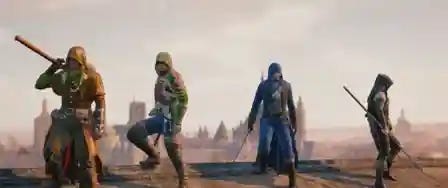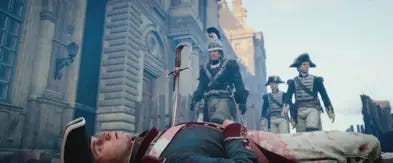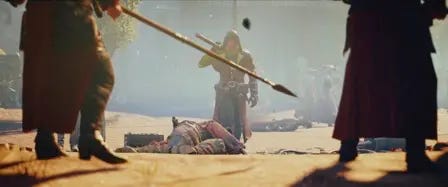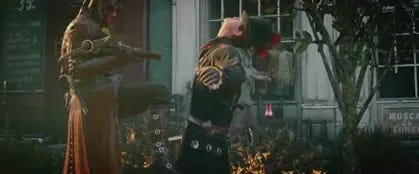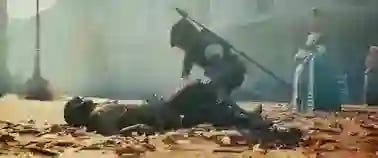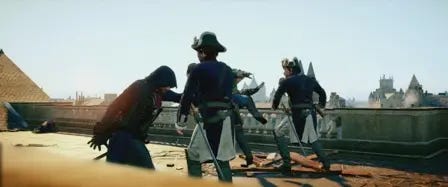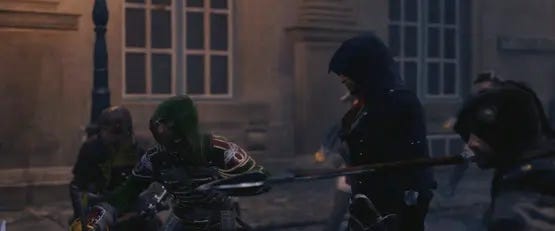Everyone Has a Script Until Production Punches You in the Face
How everything went sideways, we shot 1600:1, and I ended up loving the result anyway.
This is a little experiment.
I was pushed for time this week and so I thought I’d try something different. This is a director's commentary on an ad I did - dictating a rambling into Apple notes as I watched a video, then quickly cleaned it up. So not necessarily word-smithed. But maybe all the more raw and interesting for that.
Sorry about the random image sizes, it’s very hard to have images on email without it going oversize. I had lots of images throughout this originally and had to delete most of them.
Anyway - they’re more for reference so you know what I’m talking about in the video.
Director's Commentary: Assassin's Creed Unity Multiplayer Trailer
So this is an ad I did way back… but it’s one that I think is fun because it was such a mess of a project technically through production, while the outcome made everyone happy. We sold a lot of games (yay pre-sales stats!).
I recommend you pop out the video and read along with the timecode. You can also watch my preferred version which has no voice over here:
Not sure how this works for the audience yet. Probably not the best experience. Maybe next time I actually do the commentary onto the video and load that somewhere. But this is a newsletter which is text… so I’m not sure if the timecoding works. The point is you should be able to read it. Hmmm.
Let me know!
A bit of background. I founded the ad agency FWS with a couple of friends from other agencies back in 2013. I was Executive Creative Director - that means I was ultimately responsible for the creative coming out of the agency. We were a full service 360 ad agency - the only thing we didn’t do was media buy and our speciality niche was video games. It was great fun and I worked with a lot of good people and excellent clients.
I think one reason we were successful was that we were from classic ad agency backgrounds, and that’s how we thought - not like an entertainment agency (I don’t work there now. I’m not responsible for the new stuff).
And so to this ad. I like this ad a lot, the way it turned out. But a key reason for that the storytelling worked out, despite the fact that it was a pure grind from beginning to end. There was an idea of what we were trying to put together, but we had to throw away the script. My original script was based on expectation the game would be working when we got it. But it wasn’t.
When we talked to the client they said: fix it, do what you can do, get us an ad. Put together something that sells this idea of a multiplayer game which just didn't exist. Literally, it didn't function. I think there's two or three shots where there's actually four multiplayer characters on screen. And they're just standing around.
So. The client was okay about us dumping the script. That was a win because our client was great. But everything else about putting this together was a grind - the animations didn't work, the build of the game was not ready. That's the scheduling with two different timelines (marketing and development). But still, it was pushing the boulder uphill until you got it to the top. There was no guarantee we were going to get it to the top. I mean it goes without saying that I pulled multiple all nighters on this project.
It was quite nerve-wracking and there was a serious possibility this trailer could fail. The fact that we got something that I actually think turned out to be quite a nice little ad makes it all the sweeter.
Okay. Lets start…
Music and Brand Association
TIMECODE - 0:09
So we start with music. In any edit, music is such a huge part of whether a trailer works you spend a lot of time trying to find the right track. This is also true of any edit, but it's particularly true in a montage where the emotional drive is built around the music.
Usually the best track is something that's not very famous, but is catchy with a really driving hook that sticks in the head. Earworms are good. Then if the track works, you make it a hit and you own the brand association. And in the future, if anyone ever hears that track, you own that space in their brain - this music goes with that video game.
The example that really made me understand this was the Flock of Seagulls ad for Grand Theft Auto Vice City. It's so iconic that as soon as I hear I Ran, I think GTA Vice City.
This track grew on me. It wasn’t an immediate: this is it. But the beats… the gunfire and rhythm really dug in and grew on me. It allowed me to cut the ad in that sharp hard way with cuts to black.
And also some context. This specific asset was to push the multiplayer functionality in the game - as well as helping deliver messaging and brand values associated with Assassin's Creed Unity - the technical excellence and the beauty and the fantasie and all the other elements that make up that brand that we were selling in that campaign. This specific asset was to really push the multiplayer - that was really important to one segment of our audience.
Which was a bit of a problem because it didn’t work.
And I mean… like. Really. It wasn’t functioning at all.
Opening Sequence - Eagle Shot
TIMECODE - 0:09-0:20
So it starts off with this eagle shot and this is exactly what I'm talking about in terms of grind. This is everything - from the first shot on it's just grind, grind, grind. What you want is a beautiful long shot panning down to reveal the crowd, but the game didn't work, everything glitched.
But when it worked. It looked great. Especially back then, this was a real show off for the Playstation tech.
You're taking every frame you could possibly get and you're looking at it frame by frame to see what you can eke out here and there, then getting it to hit with the music. You're moving every single frame to try and get those movements right and make it smooth and flow - not just because the game's glitching, but because you need to get the visual flow where your eye tracking goes between shot to shot.
These introductory shots set the scene. That eagle is Assassin's Creed because that's an iconic brand thing. So we're up high, we get the city, we get Assassin's Creed. We're on a tower - Assassin's Creed - and then down into the ground and we're setting up the fantasy.
Oh yeah, I've got about the VoiceOver. I haven't seen it actually online in a long time. I'm just checking this YouTube version rather than the copy I have on my reel. There is a director's cut of course which gets rid of the voiceover. There's a surprise. So yes, this is not my finest copywriting/VO directing moment but it was kind of mandated from the US to be very explicit and well. I argued against it but there you go. It doesn’t need it. I didn’t want it. But you get hired to make a chair, you make a chair the client wants.
The Fantaisie
Ubisoft talked about the fantaisie a lot. This is an excellent way of thinking about entertainment marketing in general. And thank you to whoever at Ubisoft came up with it because I’ve stolen it and I use it all the time to organize thinking about ads. It’s a great intuition pump.
What is the fantaisie of the product? What is a fantaisie? In French it's a little more playful than the English connotations, however, the core idea is there. You want people to spend time (60 to 100 hours!) in this world. The fantaisie is all the things that make up that experience. Who the main character is, what the location is, everything that make up that world. The key question is what is the world that you're going to be brought into and spend that time in.
Or for any other product: what is the emotional-intellectual experience you promising to get when you use this product. Maybe putting on my clothes and experiencing a nicer smell which makes you think of your childhood. Maybe it’s driving a car and feeling like James Bond. You get the idea.
Movies work exactly the same way. All entertainment does. I think movies struggle with this because everyone gets wrapped up in character and story, or high concept. It’s too easy for the producers to think - what people care about are great characters. Because that seems an easier thing to control rather than the gestalt promise.
But these are all subcategories of the psychology of the fantaisie. I read someone recently saying all fiction writing is travel writing. I think that’s kind of the same idea. Where are you going to take me, and what is that journey going to be like?
Anyway. In terms of Unity and this ad, this is what these shots are setting up.
Four Assassins
TIMECODE - 0:20
We're moving down from the sky down to the ground, then we're back on the rooftops again.
This was a freaking nightmare to do. Those guys wouldn't stand together and they were putting their feet through the ceiling. This is the bit of the game that didn't work. This is the stuff we had to really try and construct from the tiniest little bits that we could find that were functional.
The guys shooting this, the cinematographers working with the game engine, would just grind and grind trying to get shots. It was a lot of work. You'd set up a shot and normally if someone puppets the characters, the characters move as you want. In this one, the puppeteers were basically unable to move the characters. It's like having actors that have suddenly taken LSD. Our shooting ration on this was way above normal… it would make even Stanley Kubrick cry. We were at about 1600:1. I’m not joking. We probably shot 60 hours. Maybe even more for a 2 minute trailer.
On the rooftop here, we're saying it's four characters. They're all assassins. That's the selling point of this ad - we're in revolutionary Paris and now we're gonna have four assassins running through it. That's the setup. That's the promise we've made within the first 12 seconds. That’s the slice of this fantaisie we’re communicating here.
I think you can oversell up front too much. People want to be drawn in. It's not about getting everything up front. It's about getting the right amount of information delivered or held back in an enticing way. It's about building enough suspense up front and grabbing you so that you want to know more.
Cut to Black
Now we cut to black. I like cutting to black. I don't like fades so much.
It always feels like you think about that last shot, you think about it, it gives you a space to think - like a comma or a pause. The cut to black is saying there's an intentionality here. Pay attention. In a cut to black you tend to pay attention to the thing you cut to black on or from. It's punctuation.
There is a distancing thing too, giving you a sense of "I am watching a constructed story," but I don't think that's necessarily a bad thing. It makes your brain work - and that is engaging. Being immersed in a story isn't just forgetting everything around you exists. It's about being engaged in the story, interacting with the text, interacting with the story. I want to know what is being told to me, I'm thinking about what that means.
The Riot Scene
TIMECODE - 0:22-0:32
Then we bring in this scene and it's all about storytelling. It's about bringing you into this world. There's been a riot. The officer is dead. Guards are walking behind - there's been a massacre.
Then we go back to that crowd again outside. They're throwing books on the fire. The whole thing is developing this story - it's the middle of revolutionary Paris.
We've got these shots coming down from the rooftop. These were just tiny fractions of bits. We had our puppeteers and cinematographers shoot all this stuff and they just shot and shot and shot anything that they could get from running around the rooftops, climbing around. It was all about trying to get two people in the frame, three people in the frame, four people in the frame. Most of the time we got two. We couldn't get three or four. It was really struggling. Even with four computers hooked up, the networking just didn't want to work.
You can see the guy does a weird spin. He lands - there's a weird spin, but we just let all that stuff go because this thing just didn't work. All this stuff is fractions of intended shots that we were able to get working between characters jumping around.
In fact in great credit to our cinematography team, we managed to get these bits of the game working when nobody else could, which was quite funny. We’d been told the project was working else where and it was our problem. But then when we fixed it - we got a phone call a few hours later from the devs team asking us… “Ummm… how did you get that working?
The Western Sequence
TIMECODE - 0:32-0:42
Then we set up a new scene. This was Western Sergio Leone stuff. Long lens, widescreen. It's very much holding back the information on who is this guy because we want to see his weapons. It's going to be high noon between these two guards and the guy who's walking with shallow focus towards them.
We don't see his face because you want to see his face. We don't let you see it because actually what's more important - I'm saying with this shot - it's not his face, it's his weapon. We're gonna go head to head with these guards, aren't we?
Then we go back to the guards. They're not paying attention. We know something's coming because that guy's got a huge ax. It's another Sergio Leone high noon Western thing. We're setting up this battle between the two guards and the one guy that's got an ax.
Inter Cutting (and Match Cutting) Between Fights
TIMECODE - 0:47-1:20
The bodies and stuff just lying around - that is a mess. Looking at it frame by frame, it's messy. Then we cut out again because I don't have any of the connecting tissue. This is pure montage storytelling - just do the brush strokes. And actually sometimes that can be better and more fun, like Breathless - shot in a slightly different version of Paris than this..
Now we're following our next multiplayer guy. The idea here is each of the multiplayer guys run off, do their own thing, and then they get together. That was the concept of the edit as I put it together because that was basically what we were able to achieve.
He goes underground. He's also getting his weapon out. Now we're doing the parallel cutting. He's sneaking around. Click, click, bang. We're kicking off with the fight.
This is all Western, Sergio Leone spaghetti westerns - that's what was going through my head when I was doing this. What I'm doing is specifically intercutting the movement so you see the movement start, then you go to the next weapon and you see a bit more of that movement. You're cutting on the movement to follow through with a different thing in a different place.
The ax cuts to the pike, which cuts back to the ax, but it's all about being in that flow movement. It could be the same fight because you're just cutting those moments to work at the right place. It could be the same location, but intercutting with different characters makes it more interesting because you're having effectively a simultaneous fight.
There's another example - he tries kicking and then on the kick, we cut to the other fight where he's also just kicked someone. These moments work quite effectively in general in montage. You start an action and you do a match cut because people are trained to understand the match cut, except you're not doing a match cut. You're doing a contrast cut, a jump cut.
That always works really nicely. It's a nice way to cut. It works especially if you get the motion flow correct so the motion in the picture goes from left to right, then right to left, and it matches the cut.
The Revival Sequence
TIMECODE - 1:21-1:25
Then the guy walks away and we have - oh no, our hero is getting spiked. So one guy won his fight, the other guy didn't. He's now spiked and he's at risk. We got some suspense here. What's going to happen to him?
Then he's coming up from the well and into the fight. This is a good example - we show him climbing up, then we show him coming up as the guy's falling down. That was entirely constructed. There is no well there. That was literally the guy crouching and then standing up.
That shot was set up so the puppeteers would have the fight in the background. He gets hit and dies or falls over, then our multiplayer character would stand up. At that time, that was about all that multiplayer build was able to do - you could have two people in the scene at the same time and one could walk and one could do the trigger animation. It was really problematic.
We got this shot - nice cinematography. Our teammate has come and finished off the guys that killed his friend. The interesting thing is in the game there is a revival thing where you can tag your teammate and bring your teammate back to life, so we were demonstrating that. The animation is nice - you're always looking for nice things in the game that give you the animation that you want and the look that shows off the cool, beautiful bits.
The Music and Editing Dance
TIMECODE - 1:26 - 2:43
This music really lends itself to repeated action so you see the same action from multiple angles. A little nouvelle vague-y type thing.
This bit requires a dance in the edit, and most editing is actually like dancing. You are dancing with the music here. These hits in the rhythm - when they hit the guys, they're hitting on beats, they cut themselves. It's very important. It's not sloppy, but it's not very exciting editing to cut to the music quote unquote. Having the cut hit on the music beat is just not very interesting. I almost never cut actually on the music beat because it just draws attention to the cut and that's not really what you want to do.
Here we're dancing the cuts and the beats and the music with the hits on the visuals. The guys are killing these guys, hitting these guys with their assassin blades or swords, and those hit on the music.
That's actually quite difficult to do. You need to really be doing frame-by-frame editing. We never retimed anything - that always looked terrible with game footage. We would shoot very high frame rate, slow motion, then speed stuff up. But we wouldn't speed ramp stuff to hit on the beat. If you're shooting slow motion, it's much easier to get some of these shots because the fights require exact timing to get the right animations.
The Final Sequence
TIMECODE - 1:40-1:55
We got these shots - you want to see the effigies, you want to see the guillotine, you want to see the massive crowds. This was one of the technical values on this game - massive crowds. There's loads and loads of crowds, loads and loads of people. This was hard back then. No-one else was able to do it.
So we're just cutting to black here because nothing else is working and we need to tell the story. Cut to black, come back in, cut to black, come back in. It feels like you're telling story and your brain fills in the bits in between.
That was a Kill Bill shot - the overhead looking down as he's wiping his blade. When we were shooting these things, we would discuss visual references, various different movies we were taking images from. We had reference books of stills from movies. The cinematography team - everybody's into movies. This is the opportunity to make your own little movie and turn it into a little ad.
These guys are running down the street because that's literally what we got - half a second of them running together.
The Ending
TIMECODE - 1:55-2:07
A bit more fighting, then the guy jumps out of a window, kills a guy on the ground, and he thinks "oh no, he's surrounded." Of course we were supposed to have a real shot to end this, of them actually surrounded and you can take it in but… the game didn’t work. We’d wrung it dry by this point.
Final Thoughts
I like the ad. I think it turned out to be a nice little spot. You get the guys coming together. The music works really well. The edit worked well in the end and it was all just because it was a grind. It wasn't working. It wasn't working. It wasn't working. You just kept grinding, changing it, changing the shots, getting new shots and piecing it together.
Then suddenly, I watched the cut and it was working. There was a story. It got the message across, it felt right. You sit down six months later and go "that sold a bunch of copies of the game that people enjoyed." You get the engagement on YouTube or wherever it's put. It's always nice that people are excited.
And. Yes. The multiplayer worked eventually. A few days after we delivered the final cut…


